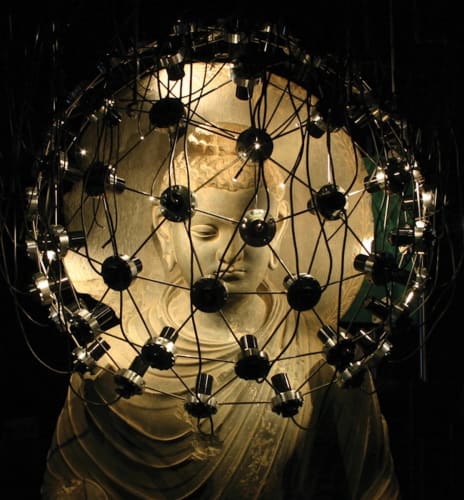
Buddhism arose in northeastern India sometime between the late 6th and early 4th centuries BCE. It is often associated with meditation, philosophical questioning, and an ethic of compassion. The popular view holds that Buddhism rejects ritual, magic, and image worship, and is largely compatible with science. Yet this characterization is strikingly different from what the religion has historically meant to Asian Buddhists. And it fails to capture the vitality that many contemporary artists—particularly those working in digital media—find in that abundant tradition.
In Korean-American artist Michael Joo’s 2005 installation Bodhi Obfuscatus (Space-Baby), 50 live surveillance cameras in a geodesic halo and 100 mirrors and monitors fragment the serene face of a late 2nd-/early 3rd-century Gandharan statue of a standing Buddha. The statue’s right hand, now broken off, was most likely originally raised with the palm facing outward, the gesture of reassurance. Aided by fiber-optic lights, the cameras cast a series of projections onto flat video screens that surround the sculpture, in a more or less direct homage to the Korean-born visionary artist Nam June Paik, the video-art pioneer who authored the concept of electronic wallpaper and created the 1974 installations TV Garden, a multiscreen literalization of its title, and TV Buddha, a seated Buddha statue perpetually contemplating its own image on a video monitor.
Joo’s work is intimate and “very silent,” he told the Brooklyn Rail in October 2022. “We had this carpeting and everything to deaden the sound as well.… The effect was to get you to focus on yourself, your own presence when you’re in the space.… As one’s eyes adjusted to the light, I wanted that whole image to be absorbed at once.”

